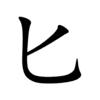匕
| ||||||||
Translingual
Han character
匕 (radical 21, 匕+0, 2 strokes, cangjie input 山竹 (UH), four-corner 22710, composition ⿺乚丿(GJKH) or ⿺乚一(T))
- Kangxi radical #21, ⼔.
Stroke order notes
PRC Standard Stroke Order: (see diagram)
| Stroke order | |||
|---|---|---|---|
 | |||
ROC Standard Stroke Order: First stroke is 橫 (not 撇).
References
- KangXi: page 152, character 18
- Dai Kanwa Jiten: character 2570
- Dae Jaweon: page 342, character 2
- Hanyu Da Zidian: volume 1, page 261, character 15
- Unihan data for U+5315
Chinese
| simp. and trad. |
匕 | |
|---|---|---|
Glyph origin
| Historical forms of the character 匕 | |||||
|---|---|---|---|---|---|
| Shang | Western Zhou | Warring States | Shuowen Jiezi (compiled in Han) | Liushutong (compiled in Ming) | |
| Bronze inscriptions | Oracle bone script | Bronze inscriptions | Chu Slip and silk script | Small seal script | Transcribed ancient scripts |
 |
 |
 |
 |
 |
 |
| Characters in the same phonetic series (匕) (Zhengzhang, 2003) | |
|---|---|
| Old Chinese | |
| 匕 | *pilʔ |
| 庀 | *pʰelʔ |
| 疕 | *pʰelʔ, *pilʔ, *pʰrilʔ |
| 朼 | *pilʔ |
| 牝 | *bilʔ, *binʔ |
Etymology 1
Pronunciation
Definitions
匕
Japanese
Vietnamese
Han character
匕 (chuỷ)
- This term needs a translation to English. Please help out and add a translation, then remove the text
{{rfdef}}.
This article is issued from
Wiktionary.
The text is licensed under Creative
Commons - Attribution - Sharealike.
Additional terms may apply for the media files.